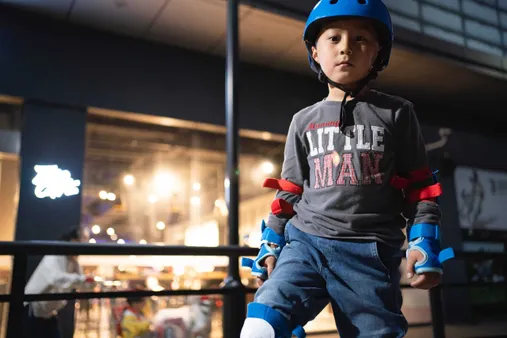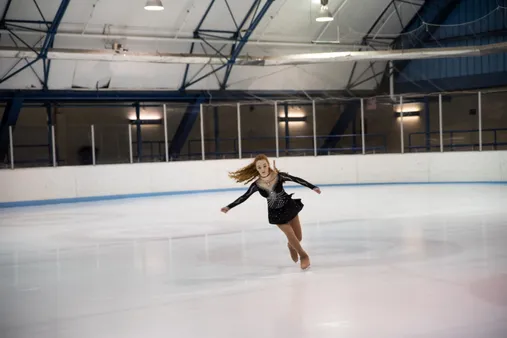Table of Contents
Embark on a journey into the world of skateboarding, where fitness and fun harmoniously converge. Discover the myriad benefits this exhilarating sport offers, from enhancing cardiovascular health and promoting coordination to providing an outlet for self-expression and fostering social connections. Whether you're a seasoned skater seeking to refine your skills or a curious newcomer eager to embrace this dynamic activity, Kizworld presents the ultimate guide to unlocking The benefits of skateboarding for fitness and fun.
The benefits of skateboarding for fitness and fun: Get rad, have fun, stay fit
I. Skateboarding: A Fun and Fit Way to Get Around
Skateboarding is not just a hobby or a sport; it's a way of life. It's a way to express yourself, to challenge yourself, and to have fun. And it's a great way to get around, too. Whether you're commuting to work or school, or just cruising around town, skateboarding is a fun and healthy way to get where you need to go.
One of the best things about skateboarding is that it's a low-impact activity. This means that it's easy on your joints, making it a great option for people of all ages and fitness levels. Skateboarding is also a great way to improve your balance and coordination. And because it's such a fun and engaging activity, it's a great way to get kids active and moving.
Of course, skateboarding can also be dangerous. That's why it's important to wear a helmet and other protective gear when you're skating. You should also be aware of your surroundings and skate in a safe area. But as long as you take the proper precautions, skateboarding is a safe and enjoyable activity that can provide you with many benefits.
Benefits of Skateboarding
- Improves balance and coordination
- Strengthens muscles and bones
- Increases cardiovascular health
- Reduces stress and anxiety
- Promotes creativity and self-expression
- Provides a sense of community
Safety Tips for Skateboarding
- Always wear a helmet and other protective gear
- Skate in a safe area
- Be aware of your surroundings
- Learn the basics of skateboarding before you start skating on your own
- Don't skate under the influence of alcohol or drugs
How to Get Started with Skateboarding
If you're interested in getting started with skateboarding, there are a few things you'll need to do.
- Choose the right skateboard for you. There are many different types of skateboards available, so it's important to choose one that's right for your skill level and riding style.
- Learn the basics of skateboarding. There are many resources available to help you learn the basics of skateboarding, such as books, DVDs, and online tutorials.
- Find a safe place to practice. Once you've learned the basics, you'll need to find a safe place to practice. A skatepark is a great option, but you can also practice in an empty parking lot or on a quiet street.
- Be patient. Learning to skateboard takes time and practice. Don't get discouraged if you don't get it right away. Just keep practicing and you'll eventually get the hang of it.
Skateboarding is a great way to get around, have fun, and improve your health. If you're looking for a new activity to try, skateboarding is a great option.
Here are some related posts that you might find interesting:
- How to Choose the Right Skateboard for Your Skill Level and Style
- The Best Skateboarding Equipment and Accessories
- How to Improve Your Balance, Coordination, and Creativity with Skateboarding
II. Health Benefits of Skateboarding
Health Benefits of Skateboarding
Skateboarding: Your Path to a Healthier You
Skateboarding, a thrilling and captivating sport, offers a myriad of health benefits that encompass both physical and mental well-being. Embracing this dynamic pastime can lead to a healthier and more fulfilling lifestyle. Let's delve into the remarkable health benefits that await you when you step onto a skateboard.
The Best Skateboarding Equipment and Accessories
Cardiovascular Health: A Journey to a Stronger Heart
Skateboarding emerges as a compelling form of cardiovascular exercise, propelling your heart to beat stronger and more efficiently. Regular skateboarding sessions can significantly reduce the risk of heart disease, high blood pressure, and other cardiovascular ailments. As you push off and glide along the pavement, your heart rate increases, promoting improved circulation and oxygenation throughout your body. Skateboarding's rhythmic nature fosters endurance, facilitating longer and more enjoyable rides.
How to Improve Your Balance, Coordination, and Creativity with Skateboarding
Muscular Strength and Flexibility: Building a Foundation of Power and Agility
Skateboarding demands a harmonious blend of muscular strength and flexibility. The continuous pushing, balancing, and maneuvering involved in skateboarding work wonders for your muscles, enhancing their strength and endurance. Your legs, core, and arms become stronger, enabling you to perform various tricks and maneuvers with finesse. Additionally, skateboarding improves your flexibility, reducing the risk of injuries and promoting overall body balance.
- Skateboarding demands a harmonious blend of muscular strength and flexibility.
- Continuous pushing, balancing, and maneuvering involved in skateboarding work wonders for your muscles, enhancing their strength and endurance.
- Legs, core, and arms become stronger, enabling you to perform various tricks and maneuvers with finesse.
- Skateboarding improves your flexibility, reducing the risk of injuries and promoting overall body balance.
Mental Health: Unveiling the Therapeutic Power of Skateboarding
The physical benefits of skateboarding are undeniable, but its impact on mental health is equally profound. This exhilarating sport fosters a sense of accomplishment and boosts self-confidence as you master new tricks and navigate challenging obstacles. The creative freedom inherent in skateboarding encourages self-expression and individuality. Furthermore, the social aspect of skateboarding, whether you're skating with friends or joining a local skate community, can combat feelings of isolation and promote mental well-being.
How to Find the Best Skateboarding Spots and Parks
Weight Management: Achieving a Healthier Body Composition
Skateboarding serves as an effective calorie-burning activity, promoting weight management and a healthier body composition. As you propel yourself forward and perform various tricks, you engage multiple muscle groups, leading to increased calorie expenditure. This, combined with the cardiovascular benefits of skateboarding, can result in significant weight loss and improved overall fitness.
The Most Common Skateboarding Injuries and How to Avoid Them
III. Skateboarding for Fun and Recreation
Skateboarding for Fun and Recreation
Skateboarding is a dynamic and exhilarating activity that offers a unique blend of physical and recreational benefits. Whether you're hitting the streets or cruising through a skatepark, skateboarding provides an opportunity to express your creativity, challenge yourself, and connect with a community of like-minded individuals.
One of the most significant benefits of skateboarding is the sense of freedom and independence it provides. When you're on a skateboard, you can explore your surroundings and move around in ways that aren't possible on foot. This freedom can be especially liberating for those who live in urban areas or have limited mobility.
From the adrenaline-fueled thrill of attempting new tricks to the camaraderie of skating with friends, skateboarding offers a range of mental and emotional benefits. It's also a great source of stress relief.
- Social Interaction: Skateboarding fosters a sense of community among enthusiasts, providing opportunities to connect with others who share your passion.
- Stress Relief: The physical activity and mental focus required in skateboarding can serve as an effective stress reliever, helping to reduce anxiety and improve mood.
- Improved Mental Coordination: Skateboarding challenges your balance, coordination, and reaction time, leading to improved overall mental and physical coordination.
- Enhanced Creativity: Skateboarding encourages creativity and self-expression, as you find new and innovative ways to navigate obstacles and perform tricks.
If you're interested in trying skateboarding, there are a few things you'll need to get started. First, you'll need a skateboard. When choosing a skateboard, consider your skill level, the type of riding you plan to do, and your budget. You may also want to consider renting a skateboard before buying one to see if it's a good fit for you.
Type of Skateboard | Recommended for |
|---|---|
Longboard | Cruising, carving, and distance riding |
Shortboard | Street skating, tricks, and park riding |
Cruiser | Casual riding and commuting |
Freestyle | Dancing, manuals, and flatland tricks |
Electric | Easy commuting and long-distance riding |
Once you have your skateboard, you'll need to learn how to ride it. There are many resources available to help you learn, including online tutorials, books, and skateboarding lessons. It's important to start out slowly and practice in a safe area. As you progress, you can start to learn more advanced tricks and explore different types of skateboarding.
Whether you're a seasoned pro or just starting out, skateboarding is a great way to get active, have fun, and make new friends. So grab your board and hit the streets!
Visit our related posts to explore more about skateboarding and discover tips, tricks, and insights to enhance your skateboarding journey:
- How to Learn the Basic Skateboarding Skills and Tricks
- The Most Common Skateboarding Injuries and How to Avoid Them
- How to Find the Best Skateboarding Spots and Parks
IV. Skateboarding Safety Tips
Skateboarding Safety Tips
Wear Protective Gear
- Helmet: A helmet is the most important piece of safety gear for skateboarding. It can protect your head from serious injury in the event of a fall.
- Knee and elbow pads: Knee and elbow pads can help protect your joints from scrapes and bruises.
- Wrist guards: Wrist guards can help protect your wrists from sprains and fractures.
Skateboarding can be a great way to get exercise and have fun, but it's important to stay safe. By following these tips, you can help reduce your risk of injury.
Learn the Basics
Before you start skateboarding, it's important to learn the basics. This includes how to stand on the board, how to push off, and how to stop. You can learn the basics by watching videos, reading books, or taking lessons from a qualified instructor.
Once you've learned the basics, you can start practicing in a safe area. A parking lot or empty field is a good place to start. As you get more comfortable, you can start skating in more challenging areas, such as skate parks or streets.
Be Aware of Your Surroundings
When you're skateboarding, it's important to be aware of your surroundings. This includes being aware of other skaters, pedestrians, and vehicles. You should also be aware of the condition of the pavement or road surface. If you see any hazards, such as cracks or potholes, you should avoid them.
By following these tips, you can help reduce your risk of injury while skateboarding. So put on your safety gear, learn the basics, and be aware of your surroundings. Then you can start enjoying all the benefits that skateboarding has to offer.
Additional Safety Tips
- Never skate under the influence of alcohol or drugs.
- Don't skate in the rain or on wet surfaces.
- Be respectful of other skaters and pedestrians.
- Obey all traffic laws.
By following these additional safety tips, you can help make skateboarding a safe and enjoyable activity for everyone.
Injury | Symptoms | Treatment |
Head injury | Loss of consciousness, confusion, nausea, vomiting | Seek medical attention immediately |
Concussion | Headache, dizziness, nausea, vomiting | Rest, ice, and over-the-counter pain medication |
Sprain | Pain, swelling, bruising | Rest, ice, compression, and elevation |
Fracture | Severe pain, swelling, deformity | Seek medical attention immediately |
Scrape | Minor bleeding, pain | Clean the wound and apply a bandage |
Bruise | Swelling, discoloration | Rest, ice, and over-the-counter pain medication |
If you experience any of these injuries, it's important to seek medical attention immediately. Early treatment can help prevent serious complications.
Skateboarding can be a great way to get exercise and have fun, but it's important to stay safe. By following these tips, you can help reduce your risk of injury.
So put on your safety gear, learn the basics, and be aware of your surroundings. Then you can start enjoying all the benefits that skateboarding has to offer.
Related posts: How to Choose the Right Skateboard for Your Skill Level and Style, The Best Skateboarding Equipment and Accessories, How to Improve Your Balance, Coordination, and Creativity with Skateboarding
V. Conclusion
Skateboarding is an activity that combines physical fitness, recreational enjoyment, and social engagement. It offers a multitude of benefits that contribute to overall well-being. Whether you are a seasoned skater or a novice, embracing skateboarding can enrich your life in numerous ways. It provides an opportunity for cardiovascular exercise, muscle strengthening, and balance enhancement. Moreover, skateboarding promotes mental well-being by reducing stress, improving mood, and fostering a sense of accomplishment. It also serves as a social activity that connects individuals, cultivates friendships, and builds a sense of community. Additionally, skateboarding can be a practical mode of transportation, offering an eco-friendly and economical alternative to motorized vehicles. As you embark on your skateboarding journey, remember to prioritize safety by wearing protective gear and following recommended safety guidelines. With dedication and practice, you can unlock the full potential of skateboarding and reap its many rewards.